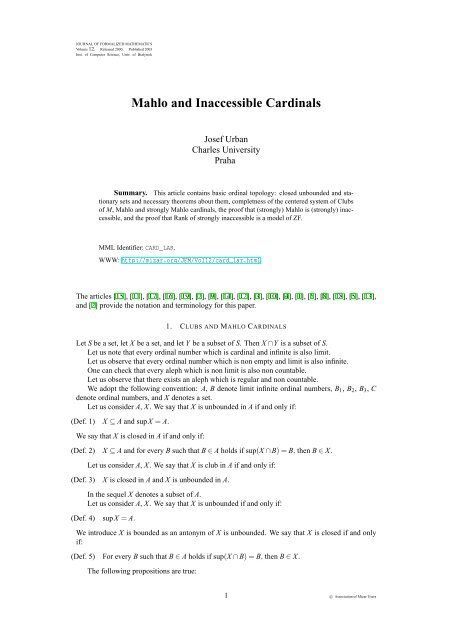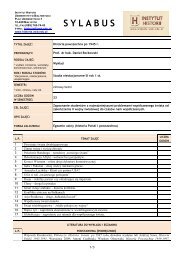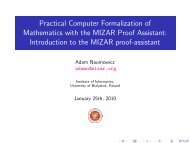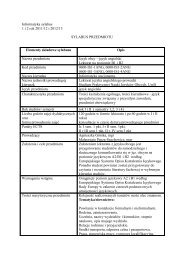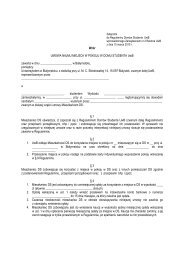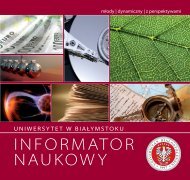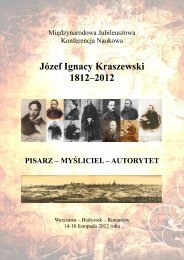stationary inaccessible
Contents - Markun Cs Shinshu U Ac Jp
Contents - Markun Cs Shinshu U Ac Jp
Create successful ePaper yourself
Turn your PDF publications into a flip-book with our unique Google optimized e-Paper software.
JOURNAL OF FORMALIZED MATHEMATICS<br />
Volume 12, Released 2000, Published 2003<br />
Inst. of Computer Science, Univ. of Białystok<br />
Mahlo and Inaccessible Cardinals<br />
Josef Urban<br />
Charles University<br />
Praha<br />
Summary. This article contains basic ordinal topology: closed unbounded and <strong>stationary</strong><br />
sets and necessary theorems about them, completness of the centered system of Clubs<br />
of M, Mahlo and strongly Mahlo cardinals, the proof that (strongly) Mahlo is (strongly) <strong>inaccessible</strong>,<br />
and the proof that Rank of strongly <strong>inaccessible</strong> is a model of ZF.<br />
MML Identifier: CARD_LAR.<br />
WWW: http://mizar.org/JFM/Vol12/card_lar.html<br />
The articles [15], [11], [17], [16], [19], [7], [9], [14], [12], [3], [10], [4], [1], [6], [8], [18], [5], [13],<br />
and [2] provide the notation and terminology for this paper.<br />
1. CLUBS AND MAHLO CARDINALS<br />
Let S be a set, let X be a set, and let Y be a subset of S. Then X ∩Y is a subset of S.<br />
Let us note that every ordinal number which is cardinal and infinite is also limit.<br />
Let us observe that every ordinal number which is non empty and limit is also infinite.<br />
One can check that every aleph which is non limit is also non countable.<br />
Let us observe that there exists an aleph which is regular and non countable.<br />
We adopt the following convention: A, B denote limit infinite ordinal numbers, B 1 , B 2 , B 3 , C<br />
denote ordinal numbers, and X denotes a set.<br />
Let us consider A, X. We say that X is unbounded in A if and only if:<br />
(Def. 1) X ⊆ A and supX = A.<br />
We say that X is closed in A if and only if:<br />
(Def. 2) X ⊆ A and for every B such that B ∈ A holds if sup(X ∩ B) = B, then B ∈ X.<br />
Let us consider A, X. We say that X is club in A if and only if:<br />
(Def. 3) X is closed in A and X is unbounded in A.<br />
In the sequel X denotes a subset of A.<br />
Let us consider A, X. We say that X is unbounded if and only if:<br />
(Def. 4) supX = A.<br />
We introduce X is bounded as an antonym of X is unbounded. We say that X is closed if and only<br />
if:<br />
(Def. 5) For every B such that B ∈ A holds if sup(X ∩ B) = B, then B ∈ X.<br />
The following propositions are true:<br />
1 c○ Association of Mizar Users
MAHLO AND INACCESSIBLE CARDINALS 2<br />
(2) 1 X is club in A iff X is closed and unbounded.<br />
(3) X ⊆ supX.<br />
(4) Suppose X is non empty and for every B 1 such that B 1 ∈ X there exists B 2 such that B 2 ∈ X<br />
and B 1 ∈ B 2 . Then supX is limit infinite ordinal number.<br />
(5) X is bounded iff there exists B 1 such that B 1 ∈ A and X ⊆ B 1 .<br />
(6) If sup(X ∩ B) ≠ B, then there exists B 1 such that B 1 ∈ B and X ∩ B ⊆ B 1 .<br />
(7) X is unbounded iff for every B 1 such that B 1 ∈ A there exists C such that C ∈ X and B 1 ⊆ C.<br />
(8) If X is unbounded, then X is non empty.<br />
(9) If X is unbounded and B 1 ∈ A, then there exists an element B 3 of A such that B 3 ∈ {B 2 ;B 2<br />
ranges over elements of A: B 2 ∈ X ∧ B 1 ∈ B 2 }.<br />
Let us consider A, X, B 1 . Let us assume that X is unbounded. And let us assume that B 1 ∈ A.<br />
The functor LBound(B 1 ,X) yields an element of X and is defined by:<br />
(Def. 6) LBound(B 1 ,X) = inf{B 2 ;B 2 ranges over elements of A: B 2 ∈ X ∧ B 1 ∈ B 2 }.<br />
The following propositions are true:<br />
(10) If X is unbounded and B 1 ∈ A, then LBound(B 1 ,X) ∈ X and B 1 ∈ LBound(B 1 ,X).<br />
(11) Ω A is closed and unbounded.<br />
Let A be a set, let X be a subset of A, and let Y be a set. Then X \Y is a subset of A.<br />
We now state two propositions:<br />
(12) If B 1 ∈ A and X is closed and unbounded, then X \ B 1 is closed and unbounded.<br />
(13) If B 1 ∈ A, then A \ B 1 is closed and unbounded.<br />
Let us consider A, X. We say that X is <strong>stationary</strong> if and only if:<br />
(Def. 7)<br />
For every subset Y of A such that Y is closed and unbounded holds X ∩Y is non empty.<br />
Next we state the proposition<br />
(14) For all subsets X, Y of A such that X is <strong>stationary</strong> and X ⊆ Y holds Y is <strong>stationary</strong>.<br />
Let us consider A and let X be a set. We say that X is <strong>stationary</strong> in A if and only if:<br />
(Def. 8) X ⊆ A and for every subset Y of A such that Y is closed and unbounded holds X ∩Y is non<br />
empty.<br />
One can prove the following proposition<br />
(15) For all sets X, Y such that X is <strong>stationary</strong> in A and X ⊆ Y and Y ⊆ A holds Y is <strong>stationary</strong><br />
in A.<br />
X.<br />
Let X be a set and let S be a family of subsets of X. We see that the element of S is a subset of<br />
The following proposition is true<br />
(16) If X is <strong>stationary</strong>, then X is unbounded.<br />
Let us consider A, X. The functor limpointsX yielding a subset of A is defined by:<br />
1 The proposition (1) has been removed.
MAHLO AND INACCESSIBLE CARDINALS 3<br />
(Def. 9) limpointsX = {B 1 ;B 1 ranges over elements of A: B 1 is infinite and limit ∧ sup(X ∩ B 1 ) =<br />
B 1 }.<br />
The following four propositions are true:<br />
(17) If X ∩ B 3 ⊆ B 1 , then B 3 ∩ limpointsX ⊆ succB 1 .<br />
(18) If X ⊆ B 1 , then limpointsX ⊆ succB 1 .<br />
(19) limpointsX is closed.<br />
(20) Suppose X is unbounded and limpointsX is bounded. Then there exists B 1 such that B 1 ∈ A<br />
and {succB 2 ;B 2 ranges over elements of A: B 2 ∈ X ∧ B 1 ∈ succB 2 } is club in A.<br />
In the sequel M is a non countable aleph and X is a subset of M.<br />
Let us consider M. One can check that there exists an element of M which is cardinal and<br />
infinite.<br />
In the sequel N denotes a cardinal infinite element of M.<br />
Next we state several propositions:<br />
(21) For every aleph M and for every subset X of M such that X is unbounded holds cfM ≤ X .<br />
(22) For every family S of subsets of M such that every element of S is closed holds ⋂ S is<br />
closed.<br />
(23) If ℵ 0 < cfM, then for every function f from N into X holds suprng f ∈ M.<br />
(24) Suppose ℵ 0 < cfM. Let S be a non empty family of subsets of M. If S < cfM and every<br />
element of S is closed and unbounded, then ⋂ S is closed and unbounded.<br />
(25) If ℵ 0 < cfM and X is unbounded, then for every B 1 such that B 1 ∈ M there exists B such<br />
that B ∈ M and B 1 ∈ B and B ∈ limpointsX.<br />
(26) If ℵ 0 < cfM and X is unbounded, then limpointsX is unbounded.<br />
Let us consider M. We say that M is Mahlo if and only if:<br />
(Def. 10) {N : Nis regular} is <strong>stationary</strong> in M.<br />
We introduce M is Mahlo as a synonym of M is Mahlo. We say that M is strongly Mahlo if and only<br />
if:<br />
(Def. 11) {N : Nis strongly <strong>inaccessible</strong>} is <strong>stationary</strong> in M.<br />
We introduce M is strongly Mahlo as a synonym of M is strongly Mahlo.<br />
One can prove the following propositions:<br />
(27) If M is strongly Mahlo, then M is Mahlo.<br />
(28) If M is Mahlo, then M is regular.<br />
(29) If M is Mahlo, then M is limit.<br />
(30) If M is Mahlo, then M is <strong>inaccessible</strong>.<br />
(31) If M is strongly Mahlo, then M is strong limit.<br />
(32) If M is strongly Mahlo, then M is strongly <strong>inaccessible</strong>.
MAHLO AND INACCESSIBLE CARDINALS 4<br />
2. PROOF THAT STRONGLY INACCESSIBLE IS MODEL OF ZF<br />
We follow the rules: A is an ordinal number, x, y are sets, and X, Y are sets.<br />
Next we state several propositions:<br />
(33) Suppose that for every x such that x ∈ X there exists y such that y ∈ X and x ⊆ y and y is a<br />
cardinal number. Then ⋃ X is a cardinal number.<br />
(34) For every aleph M such that X < cfM and for every Y such that Y ∈ X holds Y < M holds<br />
⋃ X ∈ M.<br />
(35) If M is strongly <strong>inaccessible</strong> and A ∈ M, then R A < M.<br />
(36) If M is strongly <strong>inaccessible</strong>, then R M = M.<br />
(37) If M is strongly <strong>inaccessible</strong>, then R M is a Tarski class.<br />
(38) For every non empty ordinal number A holds R A is non empty.<br />
Let A be a non empty ordinal number. Note that R A is non empty.<br />
We now state two propositions:<br />
(39) If M is strongly <strong>inaccessible</strong>, then R M is a universal class.<br />
(40) If M is strongly <strong>inaccessible</strong>, then R M is model of ZF.<br />
REFERENCES<br />
[1] Grzegorz Bancerek. Cardinal numbers. Journal of Formalized Mathematics, 1, 1989. http://mizar.org/JFM/Vol1/card_1.html.<br />
[2] Grzegorz Bancerek. Models and satisfiability. Journal of Formalized Mathematics, 1, 1989. http://mizar.org/JFM/Vol1/zf_<br />
model.html.<br />
[3] Grzegorz Bancerek. The ordinal numbers. Journal of Formalized Mathematics, 1, 1989. http://mizar.org/JFM/Vol1/ordinal1.<br />
html.<br />
[4] Grzegorz Bancerek. Sequences of ordinal numbers. Journal of Formalized Mathematics, 1, 1989. http://mizar.org/JFM/Vol1/<br />
ordinal2.html.<br />
[5] Grzegorz Bancerek. Countable sets and Hessenberg’s theorem. Journal of Formalized Mathematics, 2, 1990. http://mizar.org/<br />
JFM/Vol2/card_4.html.<br />
[6] Grzegorz Bancerek. König’s theorem. Journal of Formalized Mathematics, 2, 1990. http://mizar.org/JFM/Vol2/card_3.html.<br />
[7] Grzegorz Bancerek. Tarski’s classes and ranks. Journal of Formalized Mathematics, 2, 1990. http://mizar.org/JFM/Vol2/<br />
classes1.html.<br />
[8] Grzegorz Bancerek. On powers of cardinals. Journal of Formalized Mathematics, 4, 1992. http://mizar.org/JFM/Vol4/card_5.<br />
html.<br />
[9] Czesław Byliński. Functions and their basic properties. Journal of Formalized Mathematics, 1, 1989. http://mizar.org/JFM/Vol1/<br />
funct_1.html.<br />
[10] Czesław Byliński. Functions from a set to a set. Journal of Formalized Mathematics, 1, 1989. http://mizar.org/JFM/Vol1/funct_<br />
2.html.<br />
[11] Czesław Byliński. Some basic properties of sets. Journal of Formalized Mathematics, 1, 1989. http://mizar.org/JFM/Vol1/<br />
zfmisc_1.html.<br />
[12] Agata Darmochwał. Finite sets. Journal of Formalized Mathematics, 1, 1989. http://mizar.org/JFM/Vol1/finset_1.html.<br />
[13] Bogdan Nowak and Grzegorz Bancerek. Universal classes. Journal of Formalized Mathematics, 2, 1990. http://mizar.org/JFM/<br />
Vol2/classes2.html.<br />
[14] Beata Padlewska. Families of sets. Journal of Formalized Mathematics, 1, 1989. http://mizar.org/JFM/Vol1/setfam_1.html.<br />
[15] Andrzej Trybulec. Tarski Grothendieck set theory. Journal of Formalized Mathematics, Axiomatics, 1989. http://mizar.org/JFM/<br />
Axiomatics/tarski.html.<br />
[16] Andrzej Trybulec. Subsets of real numbers. Journal of Formalized Mathematics, Addenda, 2003. http://mizar.org/JFM/Addenda/<br />
numbers.html.<br />
[17] Zinaida Trybulec. Properties of subsets. Journal of Formalized Mathematics, 1, 1989. http://mizar.org/JFM/Vol1/subset_1.html.
MAHLO AND INACCESSIBLE CARDINALS 5<br />
[18] Josef Urban. Basic facts about <strong>inaccessible</strong> and measurable cardinals. Journal of Formalized Mathematics, 12, 2000. http://mizar.<br />
org/JFM/Vol12/card_fil.html.<br />
[19] Edmund Woronowicz. Relations and their basic properties. Journal of Formalized Mathematics, 1, 1989. http://mizar.org/JFM/<br />
Vol1/relat_1.html.<br />
Received August 28, 2000<br />
Published January 2, 2004


